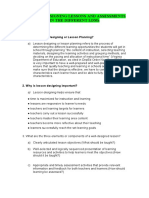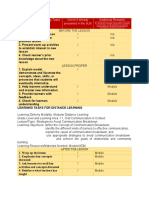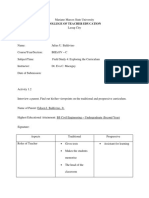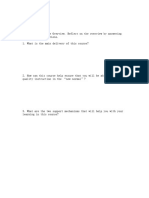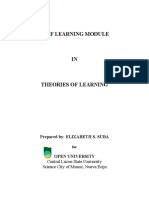0 ratings0% found this document useful (0 votes)
51 viewsLesson 2 Activity 4: Learning Tasks
The document outlines the learning tasks for a 7th grade mathematics lesson on set operations. It includes tasks before, during, and after the lesson such as reviewing previous concepts, presenting objectives, explaining concepts, providing feedback, and assessing understanding. Most of the tasks are already present in the self-learning module, but the lesson can also be presented through a video call. Learners will answer questions in their study notebook about supplemental materials, support for learners and household partners, and gathering feedback to refine lessons.
Uploaded by
Robi AmosCopyright
© © All Rights Reserved
Available Formats
Download as DOCX, PDF, TXT or read online on Scribd
0 ratings0% found this document useful (0 votes)
51 viewsLesson 2 Activity 4: Learning Tasks
The document outlines the learning tasks for a 7th grade mathematics lesson on set operations. It includes tasks before, during, and after the lesson such as reviewing previous concepts, presenting objectives, explaining concepts, providing feedback, and assessing understanding. Most of the tasks are already present in the self-learning module, but the lesson can also be presented through a video call. Learners will answer questions in their study notebook about supplemental materials, support for learners and household partners, and gathering feedback to refine lessons.
Uploaded by
Robi AmosCopyright
© © All Rights Reserved
Available Formats
Download as DOCX, PDF, TXT or read online on Scribd
You are on page 1/ 3
LESSON 2 ACTIVITY 4: LEARNING TASKS
Learning Delivery Modality (select one): ☐ODL ☒MDL ☐TV/RBI ☐BL
Grade Level and Learning Area: MATHEMATICS 7
Lesson/Topic: SET OPERATIONS
Learning Objectives: M7NS-Ia-2 Illustrates the union and intersection of sets and the difference of two sets.
- Describe what the union, intersection and complement of sets are;
- Demonstrate how the elements of the union, intersection, and complement of sets are listed;
- Illustrate the union, intersection, and complement of sets.
Learning Resources/Materials Needed: Self Learning Modules (SLM)
Part of Lesson / Learning Tasks Check if already Additional Remarks:
present in the (ex. can be done via voice calls, can be facilitated by a
SLM household partner, can be done via a learning activity sheet,
can be presented via an internet- based resource, can be
facilitated during a synchronous learning session, etc.)
Before the Lesson
1. Review previous lesson “WHAT I KNOW”
2. Clarify concepts from previous lesson “WHAT I KNOW”
3. Present warm-up activities to establish
“WHAT’S IN”
interest in new lesson
4. Check learner’s prior knowledge about the
“WHAT’S IN”
new lesson
5. Present connection between old and new
“WHAT’S NEW”
lesson and establish purpose for new lesson
6. State lesson objectives as guide for learners “WHAT I NEED TO KNOW”
Lesson Proper
1. Explain, model, demonstrate, and illustrate “WHAT IS IT” The lesson can be presented through google meet.
the concepts, ideas, skills, or processes that
students will eventually internalize.
2. Help learners understand and master new
“WHAT’S MORE”
Information
3. Provide learners with feedback. “HOW WELL DID YOU DO”
4. Check for learners’ understanding “ASSESSMENT”
After the Lesson
1. Wrap up activities “WHAT HAVE I LEARNED”
2. Emphasize key information and concepts
“WHAT HAVE I LEARNED”
discussed
3. Ask learners to recall key activities and
“WHAT CAN I DO”
concepts discussed
4. Reinforce what teacher has taught “WHAT CAN I DO”
5. Assess whether lesson has been mastered “ASSESSMENT”
6. Transfer ideas and concepts to new
“ ADDITIONAL ACTIVITY”
situations
Answer the following questions in your Study Notebook:
1. For learning tasks not found in the SLM you examined, what materials or resources can you create or curate to supplement the
SLM?
None, since all learning tasks are present in the SLM that we examined.
2. What kind of additional support can you give: a) the learner, and/or b) the household partner so that you are guided throughout
the lesson?
We shall answer whatever question or clarification they may ask through text messaging, chat or call.
3. How can the teacher gather feedback on the different learning tasks, in order to refine or modify current and future lessons?
In Modular Distance Learning, the only way to get feedback on the different learning tasks is to retrieve and assess
their activity sheets and feedback form.
You might also like
- TEAM - C3 - 5 - PIODURAN-WEST - OLAGUERA - CHERRY - O. - MODULE - 3A - Learning Tasks For DLNo ratings yetTEAM - C3 - 5 - PIODURAN-WEST - OLAGUERA - CHERRY - O. - MODULE - 3A - Learning Tasks For DL3 pages
- Output No. 2 Learning Tasks Lesson 2 Activity 4: Learning TasksNo ratings yetOutput No. 2 Learning Tasks Lesson 2 Activity 4: Learning Tasks2 pages
- Lesson 2: Designing Lessons and Assessments in The Different LdmsNo ratings yetLesson 2: Designing Lessons and Assessments in The Different Ldms5 pages
- Module 3A: Designing Instructions in The Different LDM: Lesson 2 Activity 4: Learning Tasks BLNo ratings yetModule 3A: Designing Instructions in The Different LDM: Lesson 2 Activity 4: Learning Tasks BL2 pages
- Module 3A Lesson 2 Activity 4: Learning TasksNo ratings yetModule 3A Lesson 2 Activity 4: Learning Tasks2 pages
- Lesson 2 Activity 4: Learning Tasks: MDL Tv/Rbi BLNo ratings yetLesson 2 Activity 4: Learning Tasks: MDL Tv/Rbi BL2 pages
- Learning Task For DL Hemary R. Bas Nagas Es/ Teacher 1No ratings yetLearning Task For DL Hemary R. Bas Nagas Es/ Teacher 12 pages
- Individual-Workweek-Plan WINGIE 21-25finalNo ratings yetIndividual-Workweek-Plan WINGIE 21-25final6 pages
- Learning Tasks For DL: Before The LessonNo ratings yetLearning Tasks For DL: Before The Lesson4 pages
- Lesson 2: Designing Lessons and Assessments in The Different LdmsNo ratings yetLesson 2: Designing Lessons and Assessments in The Different Ldms2 pages
- Lesson 2 Activity 4: Learning Tasks: MDL Tv/Rbi BLNo ratings yetLesson 2 Activity 4: Learning Tasks: MDL Tv/Rbi BL2 pages
- Lesson Design and Assessment: Learning Tasks For DLNo ratings yetLesson Design and Assessment: Learning Tasks For DL2 pages
- Module 5 - Parts of A Lesson Plan and Cooperative Learning StrategiesNo ratings yetModule 5 - Parts of A Lesson Plan and Cooperative Learning Strategies4 pages
- Department of Education: Learning Tasks For Distance Learning (DL)No ratings yetDepartment of Education: Learning Tasks For Distance Learning (DL)2 pages
- Learning Task For Distance Learning: Learning Delivery Modality Course 2100% (1)Learning Task For Distance Learning: Learning Delivery Modality Course 22 pages
- Elements or Components of A Curriculum DesignNo ratings yetElements or Components of A Curriculum Design5 pages
- LEARNING TASKS FOR DL and ASSESSMENT METHODS IN DL (DISTANCE LEARNING)No ratings yetLEARNING TASKS FOR DL and ASSESSMENT METHODS IN DL (DISTANCE LEARNING)3 pages
- Department of Education: Republic of The PhilippinesNo ratings yetDepartment of Education: Republic of The Philippines8 pages
- Humss Culminating Activity Quarter 3 Week 1 8 Compress100% (1)Humss Culminating Activity Quarter 3 Week 1 8 Compress27 pages
- Learner Group and Targeted InterventionsNo ratings yetLearner Group and Targeted Interventions5 pages
- DIASS12 Q1 Mod6 Disciplines-of-Social-Work v2No ratings yetDIASS12 Q1 Mod6 Disciplines-of-Social-Work v214 pages
- Activity 1: Guidelines in Daily Lesson PreparationNo ratings yetActivity 1: Guidelines in Daily Lesson Preparation7 pages
- Module 3A:: Designing Instruction in The Different Learning Delivery ModalitiesNo ratings yetModule 3A:: Designing Instruction in The Different Learning Delivery Modalities9 pages
- Project Management Planning and Scheduling Techniques 1st edition by Vijay Bansal ISBN 9781032549378 - Own the ebook now with all fully detailed content100% (19)Project Management Planning and Scheduling Techniques 1st edition by Vijay Bansal ISBN 9781032549378 - Own the ebook now with all fully detailed content70 pages
- Full download The Manga Guide to Cryptography Manga Guides Mitani pdf docx100% (3)Full download The Manga Guide to Cryptography Manga Guides Mitani pdf docx52 pages
- The Effect of Games On Vocabulary Retention: Yasmin ShabanehNo ratings yetThe Effect of Games On Vocabulary Retention: Yasmin Shabaneh12 pages
- This Agreement Is Entered To by and BetweenNo ratings yetThis Agreement Is Entered To by and Between3 pages
- Cdacc Written Assessment Nov 2024 Timetable Fair 1No ratings yetCdacc Written Assessment Nov 2024 Timetable Fair 143 pages
- Lesson 1- Primary Functions of ManagementNo ratings yetLesson 1- Primary Functions of Management37 pages
- Bologna Process Implementation Report 2020-3No ratings yetBologna Process Implementation Report 2020-341 pages
- Preparation of Production Report: Learning Activity Sheet No.100% (1)Preparation of Production Report: Learning Activity Sheet No.3 pages
- Textbook of Ear, Nose & Throat With Head and Neck Surgery For Medical StudentsNo ratings yetTextbook of Ear, Nose & Throat With Head and Neck Surgery For Medical Students2 pages
- 10 Must Read Forex Trading Quotes - ICT Tradings 2No ratings yet10 Must Read Forex Trading Quotes - ICT Tradings 21 page
- Recurrent Thyroglossal Duct Cysts: A 15-Year Review of Presentation, Management and Outcomes From A Tertiary Paediatric InstitutionNo ratings yetRecurrent Thyroglossal Duct Cysts: A 15-Year Review of Presentation, Management and Outcomes From A Tertiary Paediatric Institution6 pages
- Abstraction Application Assessment Assignment: Lesson PlanNo ratings yetAbstraction Application Assessment Assignment: Lesson Plan2 pages
- Full Download (Ebook) Language Education and Emotions by Mathea Simons (editor), Tom Smits (editor) ISBN 9780367894863, 0367894866 PDF DOCX100% (12)Full Download (Ebook) Language Education and Emotions by Mathea Simons (editor), Tom Smits (editor) ISBN 9780367894863, 0367894866 PDF DOCX81 pages
- The Intercultural Approach To EFL Teaching and Learning - Doc EFLNo ratings yetThe Intercultural Approach To EFL Teaching and Learning - Doc EFL37 pages










